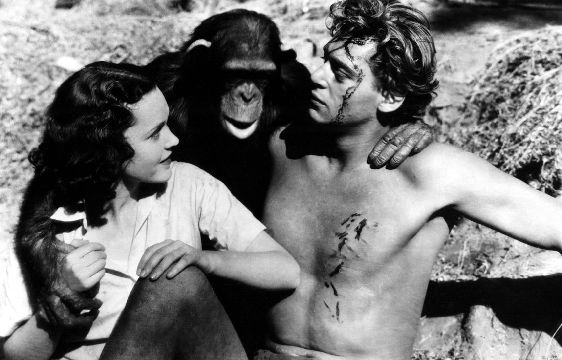Tarzan the Ape Man (1932) 
“An original M.G.M. Hit – Greatest of All!”

Director: W.S. Van Dyke
Cast: Johnny Weissmuller, Neil Hamilton, C. Aubrey Smith
Synopsis: A trader and his daughter set off in search of the fabled graveyard of the elephants in deepest Africa, only to encounter a wild man raised by apes.
Apparently, the suits at MGM seriously considered Clark Gable for the role of Tarzan, and the mind boggles at the idea of him swinging around the jungle in a loincloth. Fortunately, Gable was discarded to make way for Olympic champion Johnny Weissmuller, and the rest is cinematic history. To be honest, the first sound version of Edgar Rice Burrough’s famous character is more about Jane than it is Tarzan. She’s played here by Maureen O’Sullivan, who looks gorgeous, if just a little on the skinny side. Unfortunately, she spends most of the second half of the movie shrieking at the top of her lungs..
The story opens with Jane dropping in on her father (C. Aubrey Smith) unannounced in the African jungle (as you do) complete with half-a-dozen oversize trunks, giving us an indication as to just how unprepared — and unsuited — she is to life in the jungle. Dad is searching for the fabled Elephant’s Graveyard with the aid of Harry Holt (Neil Hamilton, largely forgotten today, but actually headlining the movie. He’s more familiar to those of a certain age as Commissioner Gordon from the 1960s Batman series), who isn’t slow to notice Jane’s comely charms.
Our intrepid explorers head off into the darkest jungle with the usual gaggle of cargo-toting, dispensable natives, and it’s not long before they find themselves facing all manner of perils. However, it’s a full half-hour before the fabled Tarzan finally makes his appearance, swinging silently through the jungle, and eventually plucking Jane like the juicy ripe fruit that she is. Naturally, Dad and Harry are a little bit put out by her abduction and set off in pursuit, cleverly trying to find her by wandering aimlessly around with one hand next to their mouth as they shout her name. Incredibly, this technique works, and it’s not long before Jane is back in the safety of the camp.
The trouble is, Tarzan’s grown a little attached to Jane, and he’s so narked by losing her that he decides to follow the expedition and pick off one of those indispensable natives every now and then. It’s a side of Tarzan that tends to be forgotten these days, the random murder of blameless labourers trying to earn a crust, but there he is, caught on camera holding one luckless chap’s head under water as he stops for a quick slurp. Anyway, Jane’s soon back in Tarzan’s clutches thanks to the intervention of his ape friends, and this time she softens towards him. Tarzan might have spent his life living in splendid isolation with wild creatures, but it’s clear that he knows what goes where, if you know what I mean, and he’s pretty damn good at it judging by that post-coital glow of Jane’s following a key fade out.
To be honest, the film tends to drag once Tarzan has Jane to himself, but when he’s forced to fight with hungry lions and malicious dwarves things heat up considerably. The lion and lioness he wrestles with are actually the real thing rather than some lame stuffed animal, and these action sequences benefit accordingly. The dwarves, sadly, are not genuine African tribesmen, but Hollywood extras. In fact, there are probably a couple of future munchkins in there somewhere. Of course, the cast never strayed from MGM’s Culver Studio back lot to make the movie, a fact that is made painfully clear by the use of some truly wretched back-projection.
(Reviewed 10th August 2013)
httpv://www.youtube.com/watch?v=lIoPPD0NKhA
